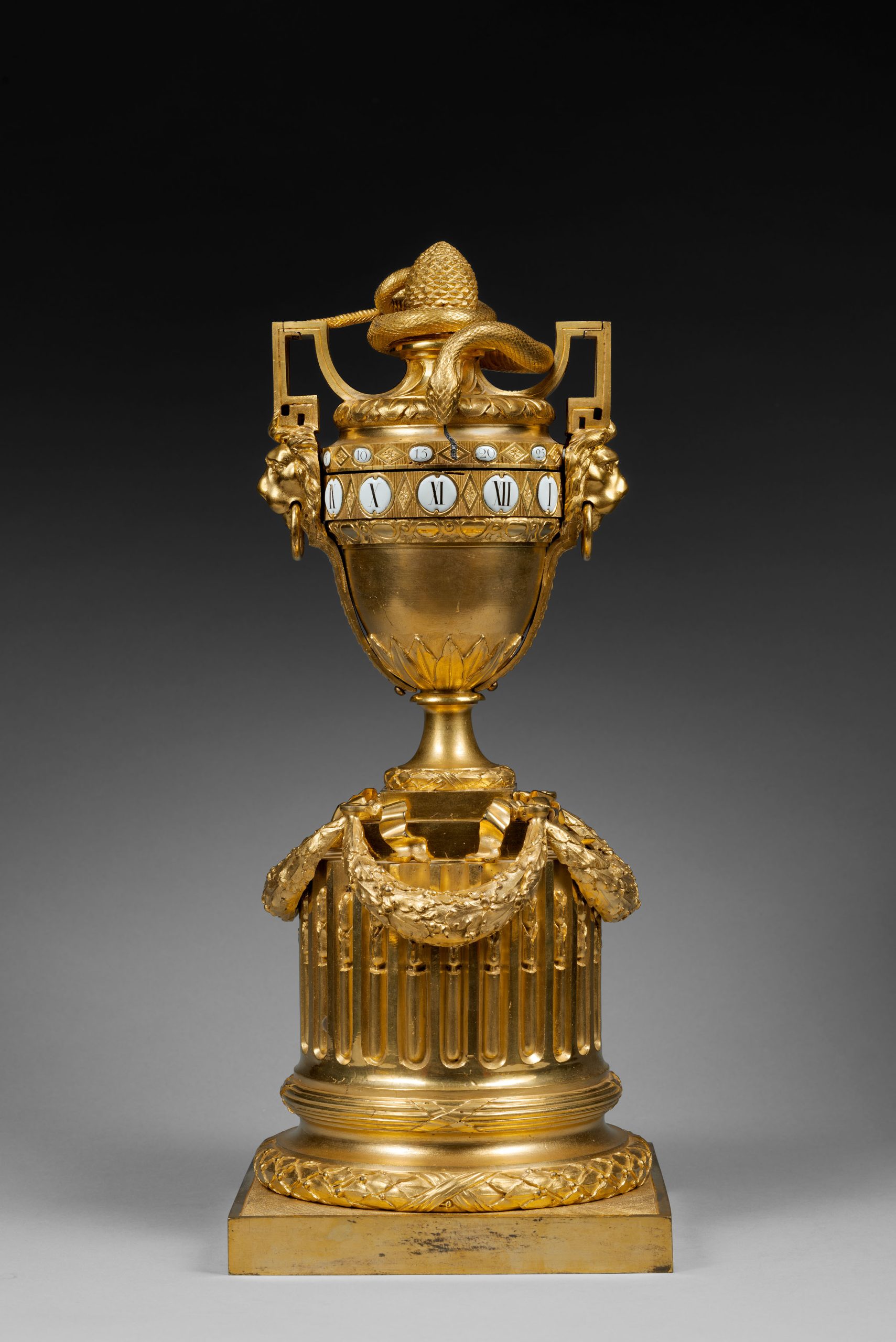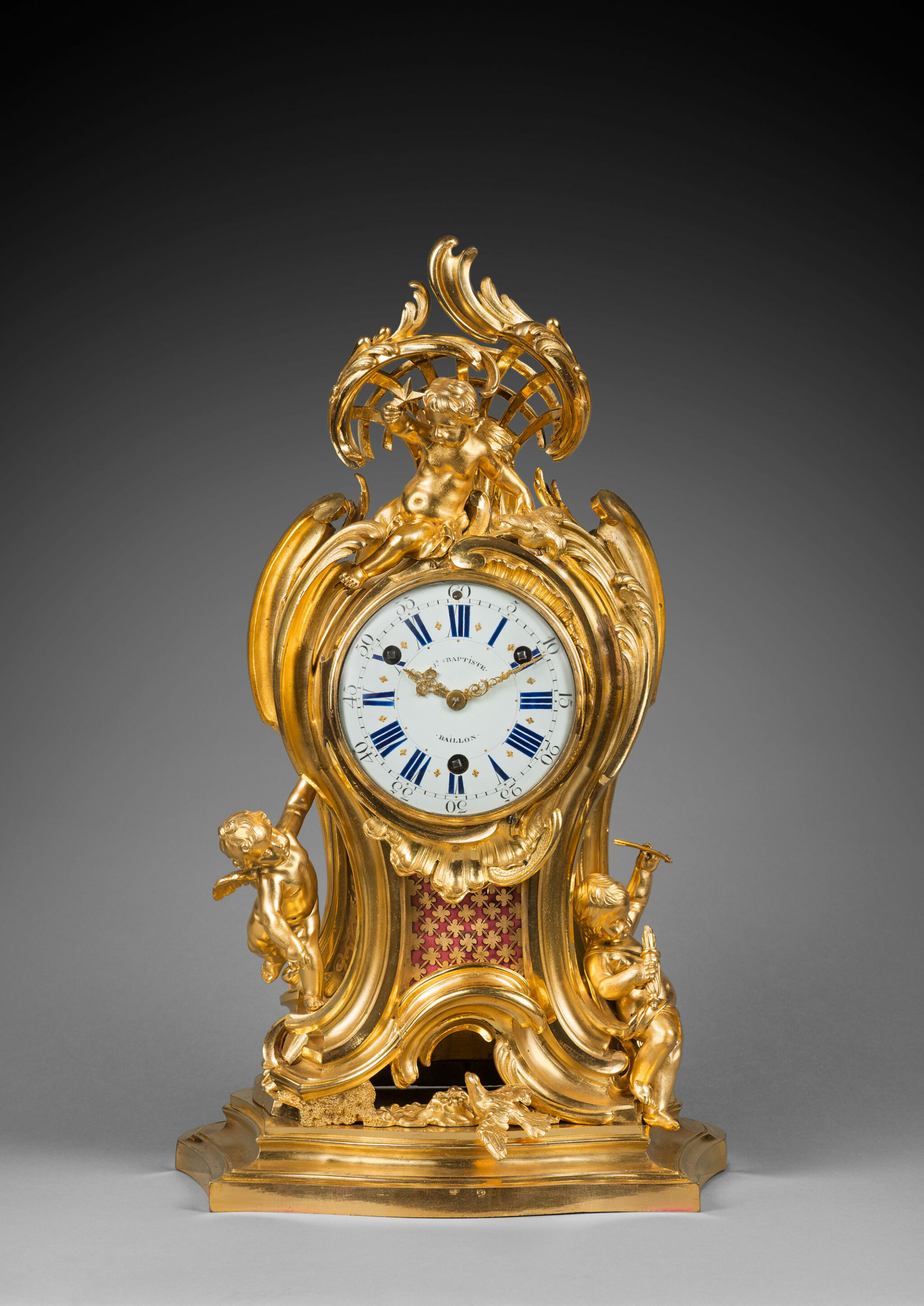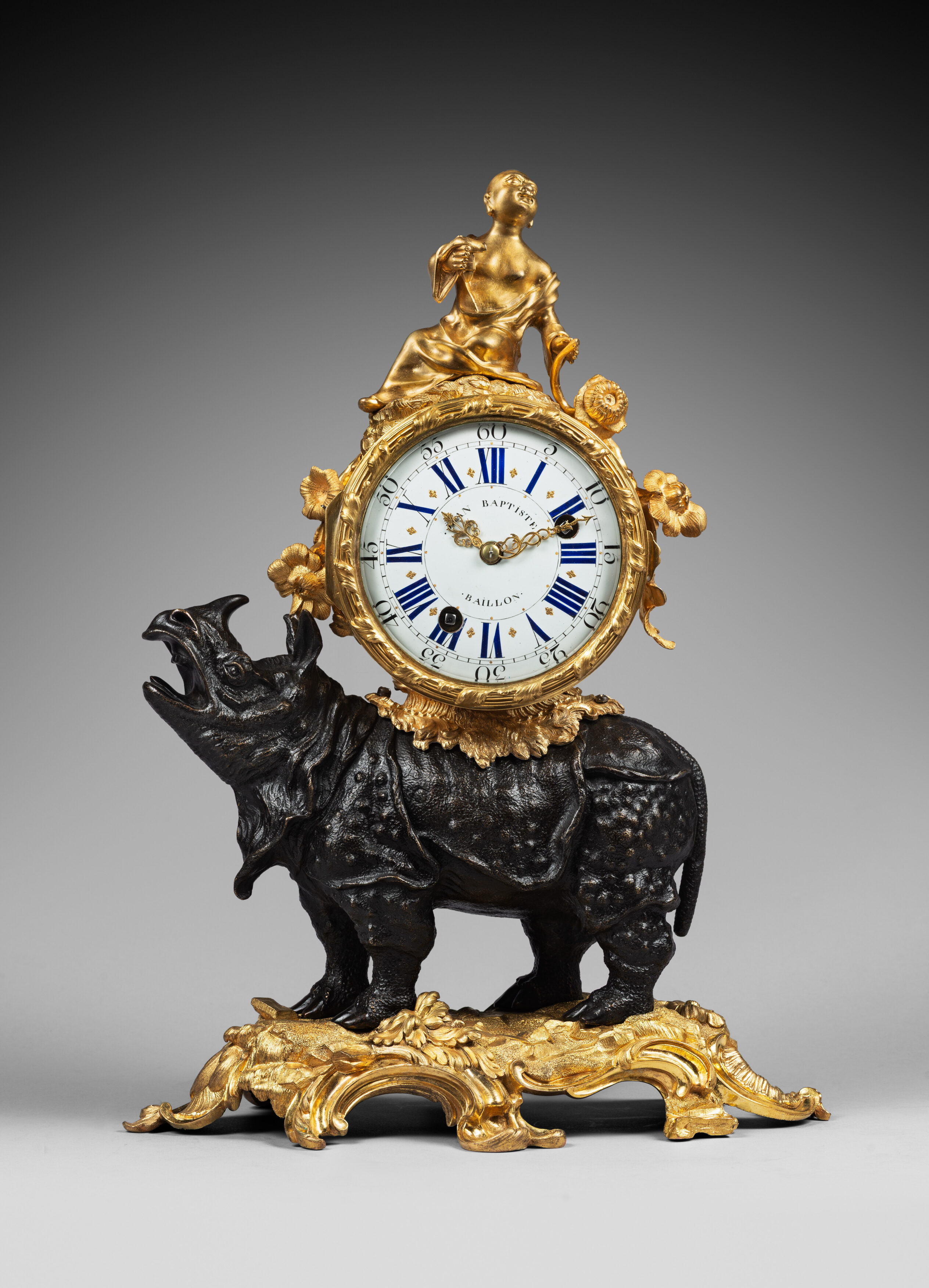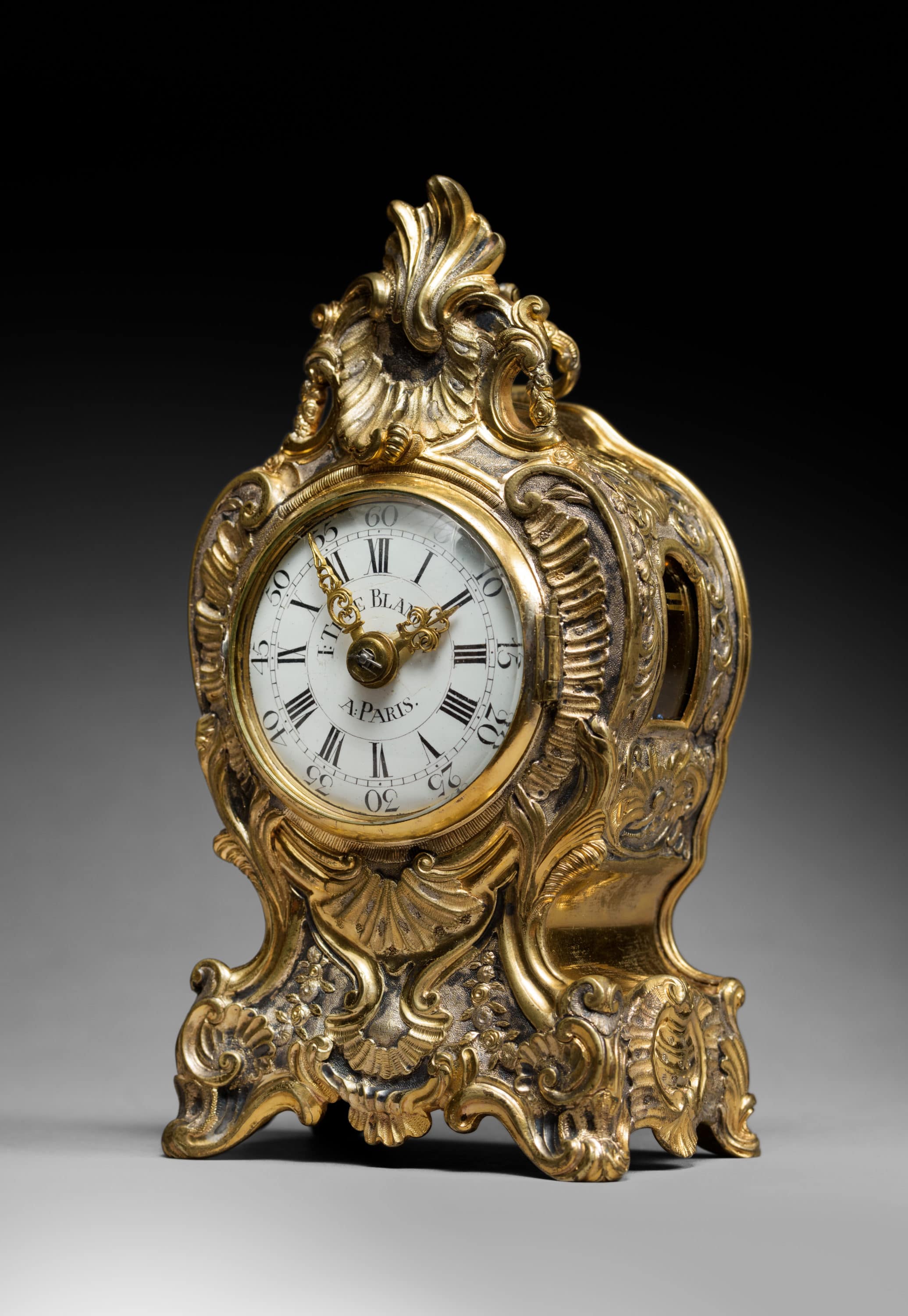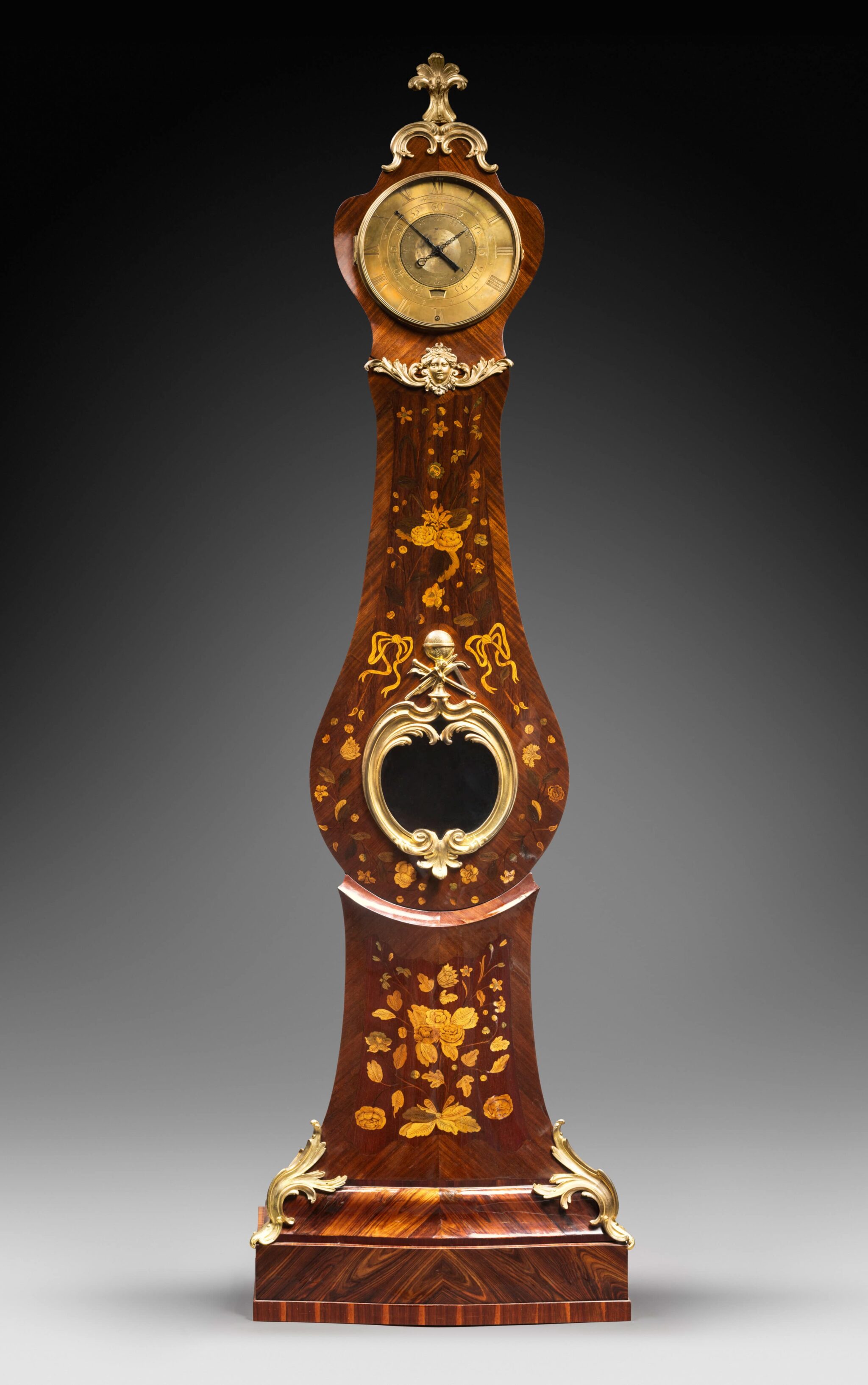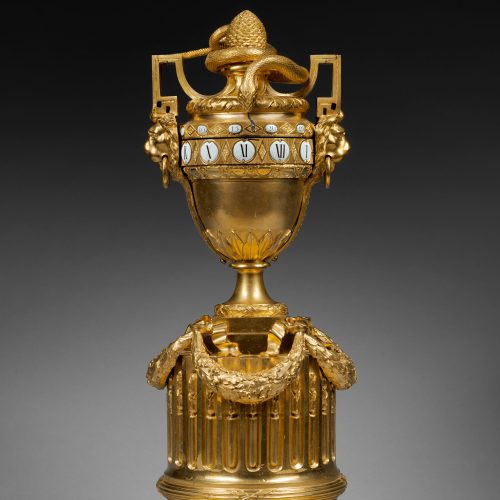A Rare Gilt Bronze Neoclassical Vase-Shaped Clock with Matte and Gilt Finishing
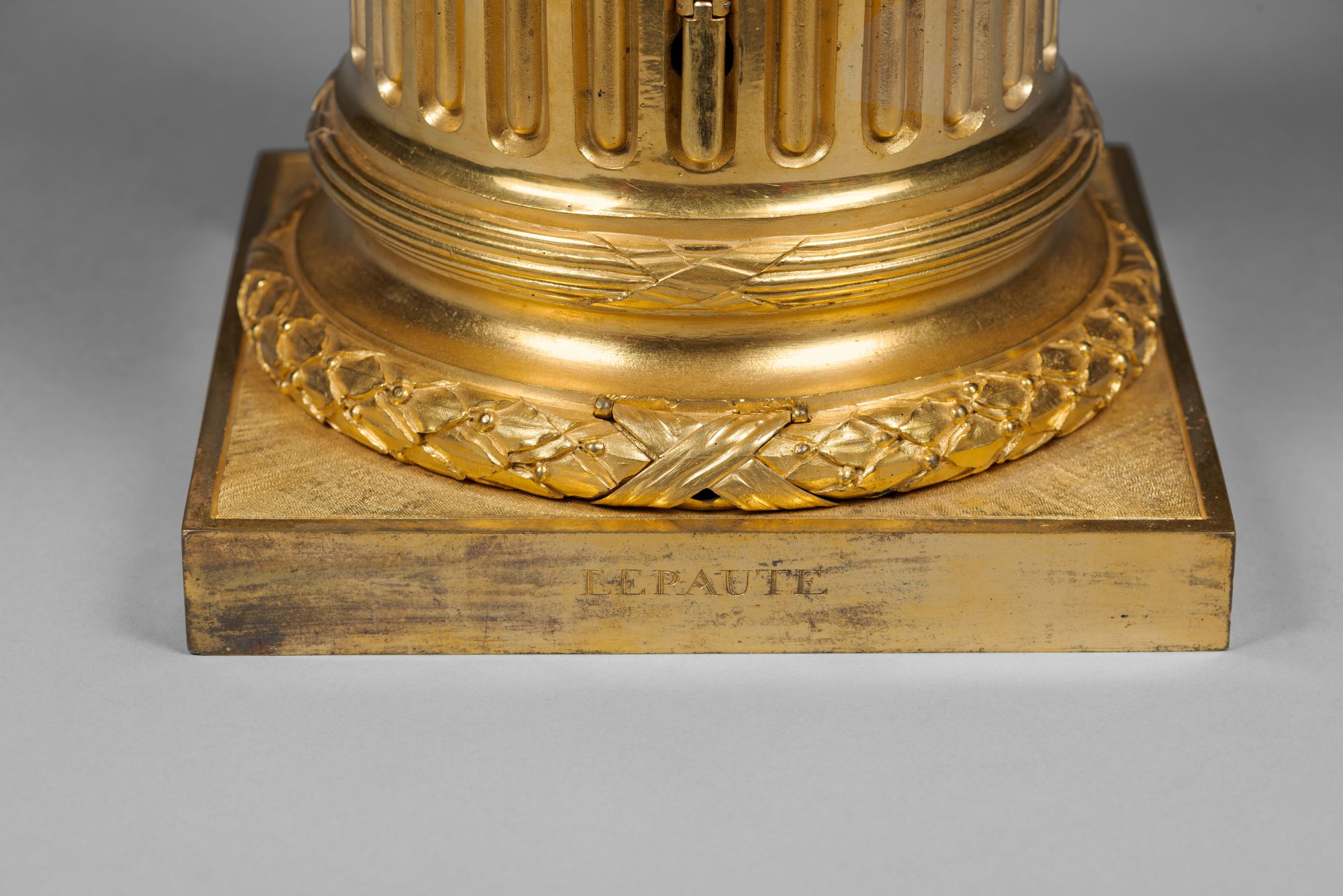
Movement signed by Jean-Baptiste Lepaute
Case Attributed to Robert Osmond
Paris, transition period between Louis XV and Louis XVI, circa 1770
The clock indicates the Roman numeral hours and the Arabic numeral five-minute intervals on enamel cartouches in two superimposed revolving dials that are decorated with lozenges set with quatrefoils. The neoclassical case is in the form of a gilt bronze baluster vase with matte and gilt finishing. The clock is surmounted by a pinecone finial around which a snake is coiled; the snake’s tongue is the pointer that marks the time on the revolving dials. The applied classical handles are adorned with lions’ heads with mobile rings in their mouths. The molded belly of the vase features a frieze with interlacing motifs above and a wreath of leaves below. The sloping base is decorated with a knop and a ribbon-tied laurel torus. The square plinth, where the slow/fast adjustment is located, is decorated with wide laurel garlands that are held in place by bows and are supported on a truncated column with wide, rudented fluting, one of which conceals the winding hole. The molded base is adorned with ribbon-tied reeds and laurel toruses. A square plinth with matte decoration, which bears the signature “Lepaute”, supports the clock.
Discover our entire collection of rare antique clocks and antique mantel clocks for sale online or at the gallery.
Clocks in the form of classical vases came into fashion in Paris during the second half of the 18th century and immediately became popular among the important collectors of the time. The model was particularly suited to the elegant cercles tournants dials, which collectors often preferred to the traditional round dials, thought to be too “ordinary”. Today, several such clock models are known, but only very few of them are as well-balanced and elegant as the present clock. Among the comparable vase-shaped clocks known, one example in the form of a vase standing on a truncated column, made by the bronze-caster Robert Osmond and the clockmaker Lepaute in 1770, is illustrated in H. Ottomeyer and P. Pröschel, Vergoldete Bronzen, Band I, Editions Klinkhardt & Biermann, Munich, 1986, p. 194. A second clock is in the Musée des Arts Décoratifs in Paris (see P. Jullian, Le style Louis XVI, Editions Baschet et Cie, Paris, 1983, p. 121, fig .4). One further such clock is in the Musée du Petit Palais in Paris (see Tardy, La pendule française, Des origines à nos jours, 2ème partie: Du Louis XVI à nos jours, Paris, 1974, p. 289, fig. 3).
Jean-André and Jean-Baptiste Lepaute
“Lepaute Horloger du Roi à Paris“: This is the signature of the brothers Jean-André Lepaute (1720-1789) and Jean-Baptiste Lepaute (1727-1802), remarkable clockmakers born in Thonne-la-Long in Lorraine who were both horlogers du Roi (Clockmakers of the King).
Jean-André came to Paris as a young man and was joined by his brother in 1747. The Lepaute enterprise, founded informally in 1750, was formally incorporated in 1758. Jean-André, who was received as a maître by the corporation des horlogers in 1759, was lodged first in the Palais du Luxembourg and then, in 1756, in the Galeries du Louvre. Jean-André Lepaute wrote a horological treatise (Traité d’Horlogerie), published in Paris in 1755. Another volume, entitled Description de plusieurs ouvrages d’horlogerie (A Description of several horological pieces) appeared in 1764. In 1748 he married the mathematician and astronomer Nicole-Reine Etable de la Brière, who among other things predicted the return of Halley’s Comet.
Jean-Baptiste Lepaute, received maître in December 1776, was known for the equation of time clock he constructed for the Paris Hôtel de Ville (1780, destroyed in the fire of 1871) and the clock of the Hôtel des Invalides.
The two brothers worked for the French Garde-Meuble de la Couronne; their clocks were appreciated by the most important connoisseurs of the time, both in France and abroad, such as the Prince Charles de Lorraine and the Queen Louise-Ulrika of Sweden.
Jean-Baptiste took over the workshop when Jean-André retired in 1775.
Discover our entire collection of luxury clocks for sale on La Pendulerie Paris.
Robert Osmond (1711 - 1789)
French bronze-caster Robert Osmond was born in Canisy, near Saint-Lô; he began his apprenticeship in the workshop of Louis Regnard, maître fondeur en terre et en sable, and became a master bronzier in Paris in 1746. He is recorded as working in the rue des Canettes in the St. Sulpice parish, moving to the rue de Mâcon in 1761. Robert Osmond became a juré, thus gaining a certain degree of protection of his creative rights. In 1753, he sent for his nephew in Normandy, and in 1761, the workshop, which by that time had grown considerably, moved to the rue de Macon. The nephew, Jean-Baptiste Osmond (1742-after 1790) became a master in 1764 and as of that date worked closely with his uncle, to such a degree that it is difficult to differentiate between the contributions of each. Robert appears to have retired around 1775. Jean-Baptiste, who remained in charge of the workshop after the retirement of his uncle, encountered difficulties and went bankrupt in 1784. Robert Osmond died in 1789.
Prolific bronze casters and chasers, the Osmonds worked with equal success in both the Louis XV and the Neo-classical styles. Prized by connoisseurs of the period, their work was distributed by clockmakers and marchands-merciers. Although they made all types of furnishing objects, including fire dogs, wall lights and inkstands, the only extant works by them are clocks, including one depicting the Rape of Europe (Getty Museum, California) in the Louis XV style and two important Neo-classical forms, of which there are several examples, as well as a vase with lions’ heads (Musée Condé, Chantilly and the Cleveland Museum of Art) and a cartel-clock with chased ribbons (examples in the Stockholm Nationalmuseum; Paris, Nissim de Camondo Museum). A remarkable clock decorated with a globe, cupids and a Sèvres porcelain plaque (Paris, Louvre) is another of their notable works.
Specialising at first in the rocaille style, in the early 1760’s they turned to the new Neo-classical style and soon numbered among its greatest practitioners. They furnished cases to the best clockmakers of the period, such as Montjoye, for whom they made cases for cartonnier and column clocks, the column being one of the favourite motifs of the Osmond workshop.
